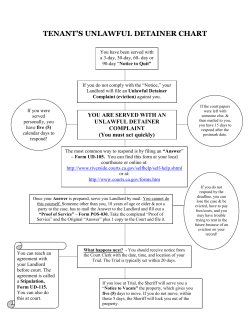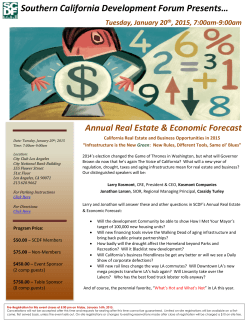
NEED SOME SPACE? A
D E NE Business// Property words by > Margot Carmichael Lester E M SOCE? SPA l real estate. ia rc e m m o c f o st o m How to make the * © getty images A recent survey from the Boston Consulting Group found that most companies aren’t effectively managing their real estate. The traditional way of managing space is per square foot, but that doesn’t factor in fluctuations such as seasonal vacancies or over-occupancy, making it difficult to use office space efficiently. “Today, the new way of looking at space is cost per employee,” notes Bob Cromwell, managing director of the office services division of Houstonbased commercial real estate firm Moody Rambin Interests. 97 Business// Property NEED SOMEE? SPAC Lease for Your Business. “What are they and how much will they fluctuate? What are the taxes? It’s possible you could negotiate caps on these.” Employee Impact “Historically, you’d typically figure three people per 1,000 square feet,” he says. Now it can be down as low as three per 840 square feet. “We’re seeing more and more C-level folks trying to get more efficient space by looking more carefully at the floor plate they’re on, where column spacing is, etc.” He’s seen some tenants do this so effectively that they dramatically reduced the amount of space occupied. “Some are moving out of oldergeneration buildings of 100,000 square feet and into a newer building of 75,000 square feet. The same amount of people in less space—that’s a tremendous hit to bottom line.” “The impact of office space is multidimensional—from employee morale and satisfaction to company culture and productivity,” says Gerald Porter, vice chairman of Cresa Partners LLC. “As hiring and retention of qualified personnel becomes more challenging in a full-employment market, the quality of the physical space that contains them becomes more critical to the ultimate success of the organization. In addition, a workplace configuration that facilitates communication, collaboration and the sharing of ideas can generate benefits to the company that will pay off into the future.” Top tips on saving space In many cases, a corporation owns real estate that’s nonessential to operations. Alex Kasdan, president of Convergence Capital Partners LLC, says, “The company and the shareholders would be better served and would get greater return on their investment if the company were to sell the real estate, realizing the full value of the asset, and lease it back at market rates. The liquidity could be used for working capital needs or as expansion capital to grow the business, increasing revenue and profitability.” Utilized vs. Used Measure space utilization, not head count. “While 100 percent of a firm’s space may be assigned, it’s only used maybe 40 to 50 percent of the time,” notes Richard Kadzis, director of special projects at CoreNet Global in Atlanta. “Companies that have figured out how to use that space are reducing the total square footage they occupy. This means tremendous cost savings and higher profits, plus the ability to respond to unexpected change without getting stuck with costly surplus space.” Itemized Charges Almost every lease includes operating and passthrough costs, usually a variable lump sum per month. These charges typically include taxes, janitorial and landscaping costs and merchant association fees, among others. “Ask what exactly constitutes operating expenses and what your landlord is going to pass through,” suggests Janet Portman, attorney and coauthor of Negotiate the Best 98 October 2006 Underperforming Asset Pay attention: Your cost for not being proactive will be someone else’s gain. Expansion Plans “If you anticipate significant growth and do not secure the necessary expansion rights, you will either continue to pay for the space you have outgrown or become a landlord, sub-landlord or assignor,” says Barry Oaks, director of Cushman & Wakefield’s Tampa office. “Most parties that become landlords by default do not do so under favorable terms. Prospective sub-landlords and assignors will need to consider the downtime to find a subtenant or assignee, broker commissions, improvement allowances, the timing and expense for landlord consent, landlord prohibitions and the reality of discounting the rent.” The key, brokers say, is paying attention—to your terms, property and operational goals. “Your cost for not being proactive,” he says, “will be someone else’s gain.”
© Copyright 2025





















